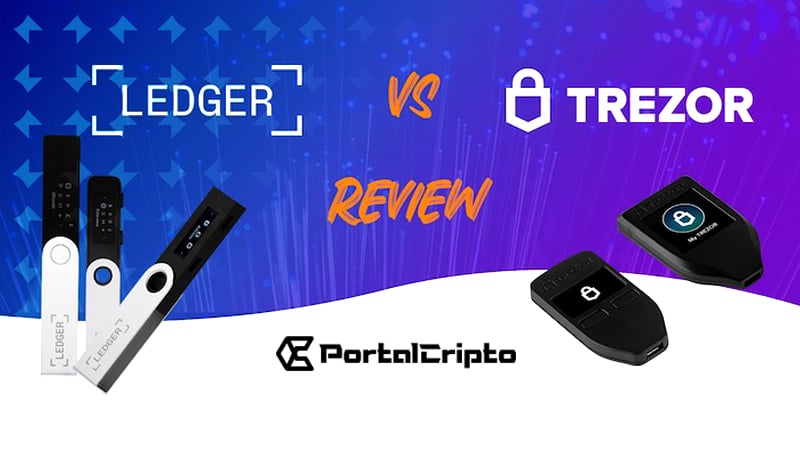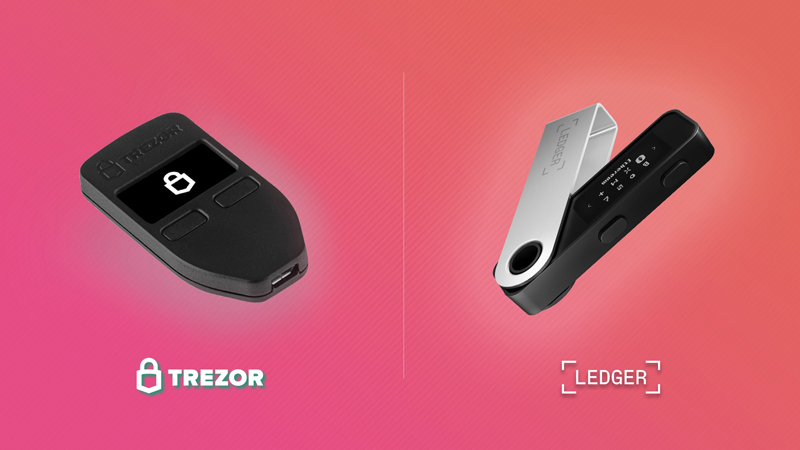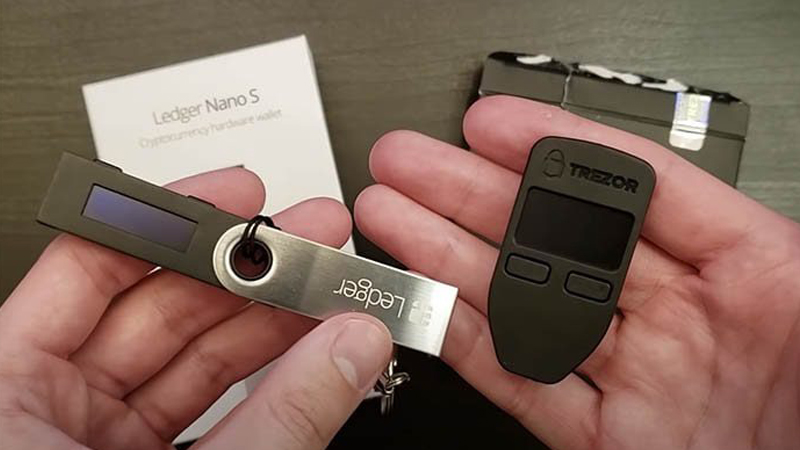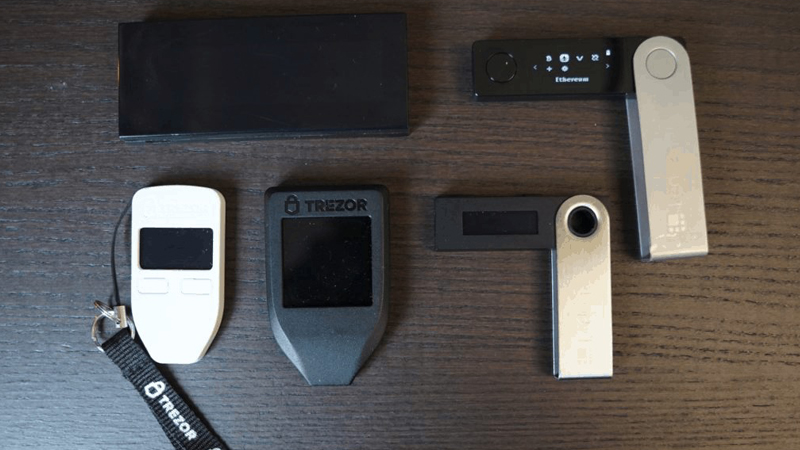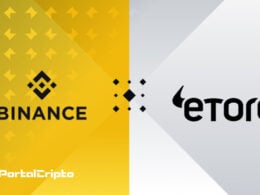Determining the ideal hardware wallet can be a challenge, especially when Ledger and Trezor present themselves as the main options. These brands are recognized for their quality in cryptocurrency storage, both offering robust features and advanced security.
Therefore, when faced with the decision to purchase a cold wallet, what would be the best choice? This article proposes a comparative analysis between Ledger e Trezor, aiming to facilitate this decision.
Main advantages:
- The Trezor Model T is highlighted by its large, colorful touchscreen, unlike the Ledger Nano X, which is equipped with a compact, monochrome OLED display.
- Both the Ledger Nano
- In terms of software, Ledger commits to closed-source firmware, while Trezor opts for an open-source firmware approach.
In this article, we will discuss:
Ledger vs Trezor: Key Differences
In the comparative evaluation between the Ledger and Trezor portfolios, several elements deserve attention. It is crucial to consider aspects such as cost, design, model range, compatibility, security features and effectiveness of customer support. This text aims to elucidate each of these aspects, providing a detailed overview to assist in choosing the most appropriate option.
| Ledger | Trezor | |
| Price | $ 79 a $ 279 | $ 69 a $ 219 |
| Compatibility | More than 50 walletsWindows, Mac OS and Linux | Unlimited hidden walletsWindows, Mac OS and Linux |
| Supported Currencies | 500+ Ledger Live App currencies 5000+ XNUMXrd party wallet currencies | 1456 coins in model T1289 coins in model One |
| NFTs | Yes | Yes |
| Staking | Support | Support |
| Connectivity | Bluetooth except Nano S PlusUSB-C for all models | USB-C to Model TUSB-A to Model One |
| Mobile app | Yes (Live Ledger) | Yes (Android only) |
Ledger vs Trezor: Similarities
- Both Ledger and Trezor provide desktop applications and integrated exchange features, promoting convenience for users.
- Both wallets allow the establishment of one main account and multiple hidden accounts using the same 24-word string for recovery.
- Both manufacturers present models with a touch screen: the Ledger Stax and the Trezor Model T.
- The wallets connect via USB cable and include PIN-enabled security features.
- Ledger and Trezor are compatible with several software wallets, including MetaMask and Atomic Wallet, among others.
Ledger Wallets: Best Crypto Cold Storage Option
Ledger Wallet is recognized as one of the most reliable options in the hardware crypto wallet market, offering a number of models including the Ledger Nano S Plus, Ledger Nano X, and Ledger Stax.
The Ledger Nano S Plus is an economical choice for securing cryptocurrencies and NFTs, featuring a compact display, USB-C connection, and weight of 21 grams. The Ledger Nano X stands out for its mobile use, with Bluetooth connectivity and features comparable to the Nano S Plus.
In turn, the Ledger Stax represents the pinnacle of the line, with a curved touch-sensitive E Ink screen, wireless charging capability and integrated magnets, weighing 45,2 grams and being physically larger than previous models.
Below is an assessment of the positives and negatives of using these hardware wallets.
Advantages of the Ledger Wallet:
- Considered one of the safest hardware wallets on the market.
- Ability to exchange and expand collections of cryptocurrencies and NFTs.
- Competitive price compared to other brands.
Disadvantages of the Ledger Wallet:
- Some models do not allow the direct acquisition of cryptocurrencies.
- Storage limitations on certain models.
Trezor Wallets: Best Hardware Wallet for Bitcoin
Trezor Wallet establishes itself as a leading cold storage solution option for cryptocurrencies, operating in the same dedicated hardware segment as Ledger Wallet. The Trezor brand mainly offers two models: the Trezor Model T and the Trezor Model One.
Model One is the original and most economical version of the Trezor, characterized by its functional design with two buttons and a screen, in addition to being compact, light and made of plastic, with a micro USB port.
In contrast, the Model T is the premium variant of the Trezor, with a sophisticated design that includes a touchscreen and USB-C port. This model stands out for advanced features such as greater privacy through Coinjoin, optimized recovery via Shamir Backup and storage expansion capacity with an SD card slot. Comparatively, it is slightly larger and heavier than the Model One, built with a plastic finish and magnetic stand.
Below is an analysis of the positive and negative aspects of these hardware wallets.
Trezor Wallet Benefits:
- Makes it easy to buy, sell, receive and monitor cryptocurrencies.
- Compatible with a wide range of tokens.
- Enables the acquisition of cryptocurrencies using fiat currency.
Trezor Wallet Limitations:
- It tends to be more expensive compared to other brands.
- It features a relatively more robust design.
Ledger vs Trezor: Pricing Analysis
The Ledger and Trezor wallets present notable distinctions in terms of price. In general, the Trezor line is positioned as the most affordable. The Trezor T, its most advanced model, is available for approximately US$219,00, while the Trezor One, a more basic version, is sold at US$69.
In contrast, Ledger's latest model, the Ledger Stax, is offered at $279. The brand's other models, including the Ledger Nano X and Ledger Nano S Plus, are priced at $149 and $79. respectively.
| Model | Price |
| Ledger Nano S Plus | US$ 79 |
| Trezor Model One | US$ 69 |
| Ledger NanoX | US$ 149 |
| Trezor Model T | US$ 219 |
| Accounting rate | US$ 279 |
Winner: Trezor
Model Comparison: Trezor vs Ledger Wallet
Within the universe of crypto wallets, Trezor and Ledger stand out with their diverse models. Each model represents an evolution in terms of functionalities, directly impacting the user experience and accessibility, without, however, compromising security. Below, a comparative analysis between the prominent models of each brand highlights the benefits provided to users.
Comparison: Ledger Nano S Plus vs Trezor One
The Trezor Model One and the Ledger Nano S Plus are the base models of the Trezor and Ledger wallets, respectively. As pioneers, some features may seem less sophisticated compared to subsequent versions, but they still offer robustness in terms of security, a characteristic inherited by more recent models. However, a negative point is the possible limitation in interfaces and storage capacity.
The highlight of the Ledger Nano S Plus lies in its cost-benefit ratio, being offered at approximately US$79. This competitive price does not detract from its capabilities, with the wallet offering cutting-edge security and supporting more than 500 types of cryptos. However, it does not have some advanced physical features present in more recent models, such as a dynamic screen, Bluetooth connection and wireless charging.
In turn, the Trezor Model One is recognized for its extensive asset support, providing access to more than 1.200 cryptos and the option to purchase with fiat currency. However, incompatibility with iOS presents itself as a significant limitation of this model.
Below is a detailed feature-by-feature analysis of each portfolio.
| Trezor Model One | Ledger Nano S Plus | |
| Supported Currencies | 1200+ | 5500+ |
| Purchase cost | US$ 69 | US$ 79 |
| Display Size | 60mm x 30mm x 6mm; 12 grams | 62,39 x 17,40 x 8,24 mm; 21 grams |
| Material | Stainless steel with plastic parts | Brushed stainless steel and plastic |
| Accessibility | Desktop Browser (Windows, Linux, Mac) | Desktop (Windows, Linux, Mac) Android 9+ |
| Connectivity | micro USB | USB-C |
Winner: Ledger S Plus
Ledger Nano X vs Trezor Model T
When choosing an elite hardware wallet to safeguard your crypto assets, the Ledger Nano X and Trezor Model T are prominent options to consider.
Both devices share a variety of features and benefits. The Ledger Nano X, however, is distinguished by its Bluetooth functionality, expanded compatibility with mobile apps, support for a greater number of cryptocurrencies and a relatively more affordable price.
On the other hand, the Trezor Model T offers its own distinct advantages, including a color touchscreen and entirely open source-based firmware.
| Trezor Model T | Ledger NanoX | |
| Supported Currencies | 1400+ | 5500+ |
| Purchase cost | US$ 219 | US$ 149 |
| Display Size | 64 mm x 39 mm x 10 mm | 72 mm x 18,6 mm x 11,75 mm |
| Touch screen | Yes | No |
| Accessibility | Desktop Browser (Windows, Linux, Mac) | Desktop (Windows, Linux, Mac) Android 9+ |
| Connectivity | USB-C | USB-C and Bluetooth |
Winner: Ledger Nano X
Ledger Stax vs Trezor Model T
The Ledger Stax and Trezor Model T models represent the latest innovations from their respective brands, bringing significant improvements over previous models, with improved design and greater ease of use, especially for beginners.
The Trezor Model T is praised for its ability to simplify transactions and asset management in crypto. With an intuitive touchscreen interface, support for over 1.400 cryptocurrencies, and a hassle-free setup process, it makes it an attractive choice for newbies. However, it is important to highlight that this model has a higher cost and a larger size compared to previous versions.
In contrast, the Ledger Stax is recognized for its elegant and compact design, adapting comfortably to the palm of the hand, as well as offering features such as a touch screen and wireless charging, which makes it easy to carry and use. This model also allows you to store NFTs and supports a wide range of cryptocurrencies through Ledger Live and associated wallets. However, its higher cost is an aspect to consider.
Below is a detailed analysis of the characteristics of each portfolio.
| Trezor Model T | Accounting rate | |
| Supported Currencies | 1400+ | 500+ Ledger Live App currencies 5000+ XNUMXrd party wallet currencies |
| Purchase cost | US$ 213 | US$ 279 |
| Display Size | 64 mm x 39 mm x 10 mm | 85mm x 54mm x 6mm; 45,2 grams |
| Touch screen | Yes | Yes |
| Material | Stainless steel with plastic parts | Aluminum and plastic with built-in magnets for stacking |
| Accessibility | Desktop Browser (Windows, Linux, Mac) | Desktop (Windows, Linux, Mac) iOS 13+Android 9+ |
| Connectivity | USB-C | USB-CBluetooth |
Winner: Ledger Stax
Compatibility Comparison: Ledger and Trezor
When it comes to compatibility, cryptocurrency hardware wallets need to integrate effectively with a variety of devices and systems to maximize their usefulness. In this context, both Ledger and Trezor present a high degree of compatibility.
Trezor's solutions are compatible with a variety of operating systems, such as Mac OS, Windows and Linux, and support a broad spectrum of software portfolios, as well as offering features such as a browser application and Bluetooth connectivity. However, one point to note is the absence of a dedicated mobile app for Trezor, although there are plans for a future launch on Android.
Ledger wallets support the same operating systems and also align with various digital wallets, in addition to having Bluetooth connectivity. Ledger's notable difference lies in the availability of mobile apps for both Android and iOS on all models, except for the Ledger Nano S Plus, which is restricted to Android.
Considering these aspects, Ledger stands out as the most compatible option.
Winner: Ledger
Wallets and cryptocurrencies supported on Ledger
Ledger brand wallets are known for their broad compatibility, supporting at least 50 different cryptocurrency wallets, which include recognized names such as Electrum, Mycrypto, MyEtherWallet, Electron Cash, PolkaDot JS, Binance and Cosmostation. This extensive list of partner wallets ensures that Ledger device users have access to a wide range of the most in-demand cryptocurrencies on the market. Below is a list of the ten most popular cryptocurrencies accessible through Ledger wallets.
1.Bitcoin (BTC)
2. Ethereum (ETH)
3. Polka Dot (DOT)
4. Binance Coin (BNB)
5. Tether USD (TRC20) (USDT)
6. Monomer (XMR)
7. Cardano (ADA)
8. Stellar (XLM)
9. Dogecoin (DOGE)
10.Ripple (XRP)
Wallet and Cryptocurrency Compatibility with Trezor
Trezor is widely recognized for its compatibility with a variety of cryptocurrencies. However, it is worth noting that the Trezor Model One has some restrictions regarding the range of supported currencies, not including widely used altcoins such as Monero, Cardano and Ripple, which are accessible on both Ledger models. Still, Trezor offers a vast catalog of cryptocurrencies available to its users. Below is a list of the ten most popular cryptocurrencies that are compatible with Trezor.
1.Bitcoin (BTC)
2. Ethereum (ETH)
3. Tether USD (TRC20) (USDT)
4. Binance Coin (BNB)
5. USD Coin (USDC)
6. Binance USD (BUSD)
7.Ripple (XRP)
8. Dogecoin (DOGE)
9. Cardano (ADA)
10.Polygon (MATIC)
Ledger vs Trezor: Staking Alternatives
O staking of cryptocurrencies in hardware wallets offers distinct advantages. Unlike staking on exchanges, where users typically incur fees, hardware wallets provide a form of staking that eliminates additional costs. For this reason, Ledger and Trezor are widely recognized as efficient staking wallet options.
Ledger Wallet, in particular, stands out for the variety of cryptocurrencies available for staking. Below is a list of cryptocurrencies that can be staked using the Ledger wallet.
1. Ethereum (ETH)
2. Earth (MOON)
3. Tron (TRON)
4. Cardano (ADA)
5. Neither (XEM)
6. Chronos (CRO)
7. Cosmos (ATOM)
8. Internet Computer (ICP)
9. Elrond (EGLD)
10. Algorand(ALGO)
11. Neo (NEO)
12. Tezzos (XTZ)
13. EOS (EOS)
In turn, the Trezor suite of wallets offers staking for a smaller number of cryptocurrencies, however, it includes some more exclusive and less common options. Below is a list of crypto assets available for staking through Trezor.
1.Algorand
2. Sunshine
3.Cosmos
4.Cardano
5. Ontology
6.tezos
7. Vechain
The rewards obtained by staking cryptocurrencies vary depending on the platform chosen to carry out the activity. These rewards are independent of hardware wallets, although different wallets provide access to different staking platforms.
Winner: Ledger
Ledger vs Trezor: Security Assessment
When it comes to security, both Trezor and Ledger are recognized for offering highly secure solutions. However, depending on the user's specific needs, small differences between them can become significant.
Trezor is notable for its robust security system, highlighting its use of Shamir backup. This advanced security protocol is designed to protect the user's seed phrase from loss or theft. Additionally, Trezor implements the Bitcoin Enhancement Proposals, allowing users to add an additional passphrase to their existing seed phrase, further raising the level of security.
In contrast, Ledger wallets incorporate secure elements such as Bankrate Secure Elements (SE), which are specialized chips designed to defend the wallet against attempted external attacks. Furthermore, Ledger wallets use BIP39 passwords and operate on closed-source firmware, unlike the open-source model adopted by Trezor, which means that Ledger's software is not open to external inspection.
Winner: Draw (both are highly safe)
Which hardware wallet is easier to use, between Ledger and Trezor? Both portfolios have their strengths, but Ledger takes the lead. While the latest Trezor model has a color touchscreen that makes navigation more manageable, it doesn't have a mobile app. This means that users must constantly be near a PC or desktop to use the wallet, making it cumbersome for most users.
On the other side of the scope, Ledger's latest model, the Stax, has a color touchscreen and a mobile app for Android and iOS users. Additionally, Ledger Stax has other advanced features such as longer battery life, wireless charging, palm-sized design, and a sleek surface that makes it easily portable.
Winner: Ledger
Ledger vs Trezor: Ease of Use Comparison
When considering the ease of use between Ledger and Trezor hardware wallets, they both offer advantageous attributes, with Ledger often coming out ahead in this category. The Trezor Model T, with its color, touchscreen display, provides an enhanced browsing experience, but the lack of a mobile app may limit its convenience for users who want to manage their assets on the go, as it requires constant proximity to a computer.
On the other hand, the Ledger Stax model not only includes a color touchscreen but also supports mobile apps for both Android and iOS. Added to these features are a long-lasting battery, wireless charging capability, a compact design that fits in the palm of your hand, and a sleek surface for optimized portability.
Winner: Ledger
Ledger vs Trezor: How to Set Up
Ledger device configuration:
1. Download the Ledger Live app on your mobile device or computer.
2. Connect the Ledger device to your phone or computer and follow the instructions displayed to start a new device or restore an existing one.
3. Set a PIN code to protect your device and validate your choice.
4. Write down the recovery phrase on a recovery sheet and keep it in a safe place as it serves as a backup for restoring accounts in case your device is lost or damaged.
5. Use Ledger Live to install the applications corresponding to the crypto assets you want to manage, supporting the installation of up to 100 applications, varying according to the size of each one.
6. Add your accounts to Ledger Live to monitor and manage your crypto assets, as well as make purchases, exchanges, loans and access other available services.
Trezor device configuration:
1. Connect the Trezor device to your computer and go to trezor.io/start in your browser.
2. Select your Trezor model and follow the instructions to install the firmware.
3. Choose between “Create new wallet” or “Recover wallet”, depending on whether you already have a backup.
4. Back up your recovery seed by recording the words provided by the device on the included card.
5. Establish a PIN for additional security of your device, using the blind matrix system for greater protection.
6. Name your device and set an additional password for extra security if desired.
7. Use your Trezor device with Trezor Suite or other supported apps to manage your crypto assets.
Conclusion
In this comparison between Ledger and Trezor, we evaluate each portfolio according to several criteria. Both prove to be robust alternatives for the secure storage of cryptocurrencies. Choosing the ideal wallet varies depending on individual preferences, budget limitations and the specific requirements of each user.
Trezor stands out for being more accessible in its basic version, while Ledger is recognized for offering a greater variety of cryptocurrencies and more storage capacity for third-party applications.
The preference between Trezor's open source software and Ledger's closed source software may also vary between users. Some value the transparency and modifiability that open source offers, while others may prioritize the perceived security and exclusivity of closed source software.
FAQ
Which to choose, Trezor or Ledger?
The selection between Trezor and Ledger must align with the specific needs of the user. Ledger wallets are notable for their extensive security features, ANSII regulation, refined aesthetics, and extensive cryptocurrency staking options. In contrast, Trezor wallets offer access to less common cryptocurrencies and integration with apps like Exodus Wallet, known for their attractive returns.
Who has greater security, Ledger or Trezor?
In terms of security, Ledger wallets are considered superior to Trezor, which are regulated by ANSII and have closed-source firmware that limits external access to programming. Additionally, Ledger devices include secondary Bankrate Secure Elements chips for additional protection, a feature missing from Trezor wallets.
Between Trezor and Ledger, which one offers better value for money?
The Trezor Model One is available for US$69, while the Trezor Model T costs US$219. On the other hand, Ledger wallets are relatively more affordable, with the Ledger Nano S Plus costing US$79 and the Ledger Stax for $279.
What are the advantages of Ledger Nano X over Trezor Model T?
The Ledger Nano
Why consider Trezor safer than Ledger?
Trezor has an advantage by making its firmware available as open source, allowing anyone to examine and audit the code, unlike Ledger's closed, proprietary firmware. Additionally, Trezor offers the Shamir Backup feature, which allows the recovery seed to be divided into several parts for separate storage, adding an extra layer of security in case of loss or damage to the device.
Can Ledger or Trezor wallets be hacked?
Ledger and Trezor hardware wallets are designed to maximize security and minimize the chances of being compromised. However, as no system is infallible, there are certain risks and vulnerabilities that can threaten the security of assets.
Risks include loss of the recovery device or seed, resulting in irreversible loss of funds. Additionally, entering the PIN or seed on a compromised device can lead to the exposure of private keys to malicious software or phishing schemes. Purchasing a counterfeit or modified device from an untrustworthy supplier also increases the risk of supply chain attacks.
To mitigate these risks, it is essential to adopt best security practices, including:
- Purchase the device directly from official sources or authorized dealers.
- Check the authenticity and integrity of the device before use.
- Keep your device and software up to date with the latest firmware and security updates.
- Create a robust PIN and store the recovery seed in a secure, inaccessible location.
- Enter the PIN and seed exclusively on the hardware wallet and never on other devices.
- Maintain the confidentiality of the PIN and seed, avoiding sharing them with third parties.





